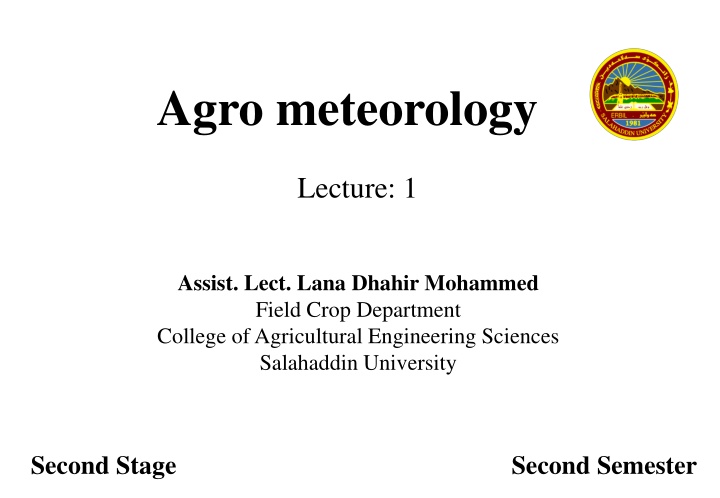
Agro-meteorology for Agriculture
Agro-meteorology, a blend of agriculture and meteorology, plays a crucial role in crop production by aiding in planning, optimizing sowing dates, managing resources efficiently, and mitigating weather-related risks. This field helps farmers make informed decisions regarding irrigation, crop protection, and environmental conservation based on weather forecasts. Leveraging agro-meteorology can lead to increased crop yields, reduced losses, and sustainable agricultural practices.
Download Presentation

Please find below an Image/Link to download the presentation.
The content on the website is provided AS IS for your information and personal use only. It may not be sold, licensed, or shared on other websites without obtaining consent from the author. If you encounter any issues during the download, it is possible that the publisher has removed the file from their server.
You are allowed to download the files provided on this website for personal or commercial use, subject to the condition that they are used lawfully. All files are the property of their respective owners.
The content on the website is provided AS IS for your information and personal use only. It may not be sold, licensed, or shared on other websites without obtaining consent from the author.
E N D
Presentation Transcript
Agro meteorology Lecture: 1 Assist. Lect. Lana Dhahir Mohammed Field Crop Department College of Agricultural Engineering Sciences Salahaddin University Second Stage Second Semester
Meteorology Greek word Meteoro means above the earths surface (atmosphere) logy means indicating science Meteoro + logy = Meteorology Meteorology is a combination of both physics and geography. This science utilizes the principles of Physics to study the behaviour of air. It is concerned with the analysis of individual weather elements for a shorter period over a smaller area. In other words, the physical state of the atmosphere at a given place and time is referred to as weather . The study of weather is called meteorology . It is often quoted as the physics of atmosphere . Weather: Physical state of the atmosphere at a given place and given time in a short time. Climate: Long term regime of atmospheric variables of a given place or area . Why do we need meteorology? Meteorology is important because of the impact of air conditions on life. First of all weather forecasting has vital role in urban administration. ... Meteorology is important for farmers since crops need water to grow up. Meteorology is also important for both air and marine transportation.
Agro meteorology: Agriculture+Meteoro+logyAgricultural meteorology is A branch of applied meteorology which investigates the physical conditions of the environment of growing plants or animal organisms, An applied science which deals with the relationship between weather/climatic conditions and agricultural production. An applied science which deals with the relationship between weather/climatic conditions and agricultural production. A science concerned with the application of meteorology to the measurement and analysis of the physical environment in agricultural systems. The word Agrometeorology is the abbreviated form of agricultural meteorology. To study the interaction between meteorological and hydrological factors on the one hand and agriculture in the widest sense, including horticulture, animal husbandry and forestry on the other Why is agrometeorology station important to agriculture? The station gets data from the sensor for transmission via SMS or Satellite network. The device was developed to reduce vulnerability of the agriculture specifically resource-poor upland farmers and communities to the impacts of climate change and related natural disasters through timely and accurate data monitoring. What are the weather elements? They are temperature, atmospheric pressure, wind, humidity, precipitation, and cloudiness. Together, these components describe the weather at any given time.
IMPORTANCE TO CROP PRODUCTION 1. Helps in planning cropping patterns/systems. 2. Selection of sowing dates for optimum crop yields. 3. Cost effective ploughing, harrowing, weeding etc. 4. Reducing losses of applied chemicals and fertilizers. 5. Judicious irrigation to crops. 6. Efficient harvesting of all crops. 7. Reducing or eliminating outbreak of pests and diseases. 8. Efficient management of soils which are formed out of weather action. 9. Managing weather abnormalities like cyclones, heavy rainfall, floods, drought etc. This can be achieved by (a) Protection: When rain is forecast avoid irrigation. But, when frost is forecast apply irrigation. (b) Avoidance: Avoid fertilizer and chemical sprays when rain is forecast (c) Mitigation: Use shelter belts against cold and heat waves. 10. Effective environmental protection. 11. Avoiding or minimizing losses due to forest fires.
Earth is elliptical in shape and has three spheres Hydrosphere - the water portion Lithosphere - the solid portion Atmosphere - the gaseous portion Atmosphere : The atmosphere is the colourless, odourless and tasteless physical mixture of gasses which surrounds earth on all sides. It is mobile, compressible and expandable. It contains huge number of solid and liquid particles called aerosol. Some gases are permanent atmospheric constituents in fixed proportions to the total gas volume. Others very from place and time to time. The lower atmosphere where the chemical composition of gas is uniform is called homosphere. At higher levels the chemical composition of air changes considerably and known as heterosphere. Uses of atmosphere 1. Provides oxygen which is useful for respiration in crops 2. Provides carbon-dioxide to build biomass in photosynthesis. 3. Provides nitrogen which is essential for plant growth. 4. Acts as a medium for transportation of pollen. 5. Protects crops plants on earth from harmful U.V.rays. 6. Maintains warmth to plant life and 7. Provides rain to field crops as it is a source of water vapour, cloud, etc.
Composition of atmosphere The following all the different gases that are present in percentage by volume approximately. Nitrogen (N2) = 78.08 Oxygen (O2) = 20.95 Argon (Ar) =0.93 CO2 =0.03 . Neon (Ne) = 0.0018 Helium(He) =0.0005 Ozone(O3) =0.00004 Hydrogen(H2) =0.00006 Methane (CH4) =0.00017
Vertical Layers of atmosphere based on temperature is divided into different spheres or layers. Troposphere Stratosphere Mesosphere/Ozonosphere Thermosphere(Ionosphere) Exosphere.






















